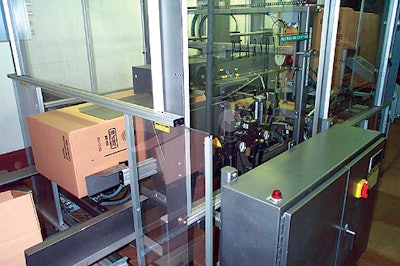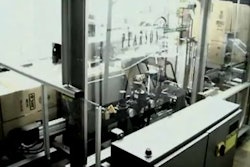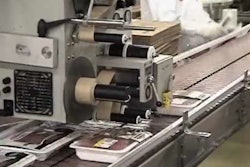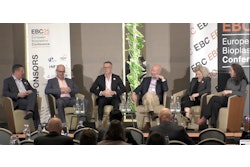With floor space at a premium, Quintex Corp., Spokane, WA, turned to the only direction it could to expand its case-packing capacity: up. And when the plastic molding company needed its box-forming to keep pace with a new blow molder, it turned to nearby Pearson Packaging (Spokane, WA).
These two factors culminated in the installation of a Model R235 case erector and bottom sealer in September 2001 on a mezzanine located 30’ above the plant floor. The distance from the blow-molding operations serves to isolate any corrugated dust, notes Dorothea Christiansen, Quintex president. Previously, the mezzanine was used for plastics material handling and storage. Production manager Ken Parks says the company added an additional roller conveyor and “beefed up” the mezzanine for the erector.
Glued cases exit the erector and are conveyed from the mezzanine level down a 45º conveyor. Where the case and bottle conveyors intersect, a worker packs the 2-, 4-, or 6-count boxes with freshly molded 1-gal high-density polyethylene industrial round containers. Six-count cases were packed during Packaging World’s visit.
Quintex declines to identify how fast it operates the machine. However, Parks acknowledges that it has operated on occasion as fast as 20 cases/min. It can erect 35/min of the largest size, he adds, and can run smaller cases even faster. Parks says Pearson was selected for its reputation, service and proximity. The equipment runs 24 hours per workday.
Changing from manual case erecting has improved output, case quality, and labor, relates Christiansen. “People aren’t as tired at the end of the day and get more satisfaction out of their work,” she says. “Once set, the case erector has been very consistent—we don’t have to worry about the quality of the boxes.” The erector is run by a programmable logic controller.
Space restrictions
With a footprint of 75 sq’, the erector fits snuggly under a ceiling that’s only 6’. Quintex had Pearson extend the horizontal supply hopper on the erector from 4’ to 6’ to reduce the loading frequency. Parks estimates that the 50% added length nearly doubled the run time to about 45 minutes before the supply is exhausted. The 32’’ loading height addresses ergonomic concerns.
The suppliers of the corrugated cases are Boise Cascade (Boise, ID) and Weyerhaeuser (Federal Way, WA). Specifications are set by Quintex’s customers, but a typical construction is 32 ECT. Parks adds that most are flexo-printed in one color, though some feature two-color printing.
Lying on their edges, the knocked-down cases are indexed into position and picked off the supply magazine by a reciprocating assembly equipped with vacuum cups. The case is pulled in the machine direction and onto a chain belt. The cases are transported through the unit on their sides. Another assembly with vacuum cups, arcing upward, squares up the case. Pneumatic actuators tuck in the minor flaps before glue is applied.
Next, the major flaps are plowed in by guides before a pneumatic ram compresses the case bottom against a fixed plate. A stationary bar at the discharge turns the cases upright as they drop onto a belt conveyor that transfers them to the production floor below.
Box-size changeovers are made every two to three days, and average 15 minutes. “All equipment suppliers claim to have quick changeover,” offers Parks, “but you have to go by what you can see. With Pearson’s equipment, done using guides and handcranks, it is impressive.”
“We have been very happy with the equipment, it is a workhorse,” sums Christiansen. “Any issues have been dealt with by Pearson very quickly—they are very good people to work with. Their equipment tends to be expensive, but you get what you pay for.” In Quintex’s case, that meant a lot of “upside” potential.


























